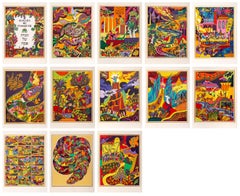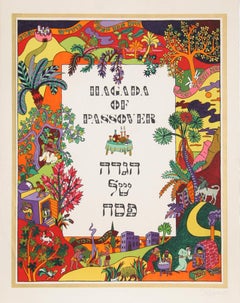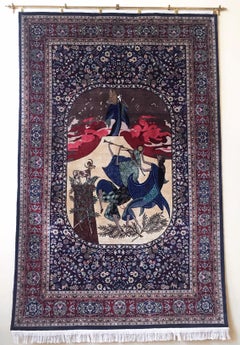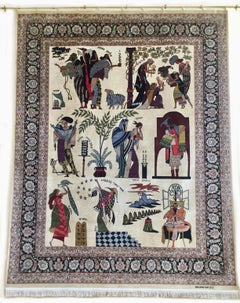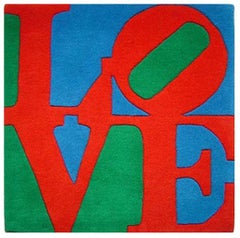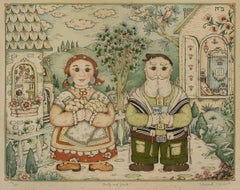Shlomo Katz Art
Israeli, Polish, 1937-1992
Shlomo Katz was born 1937 in Lodz, Poland and he immigrated to Palestine in 1945 at the age of eight. He went to school at Kibbutz Mishmar Ha'emek, and his teachers noticed his artistic ability from the beginning. He then went to Paris to pursue art where he studied at the Ecole de Beaux Arts. It was there that he developed his original technique of oil painting on a gilded metal surface. This gold surface and his rich colors resemble oriental miniatures and medieval icons.
Katz’s serigraphs became the ultimate in modern printmaking and in 1985 he was commissioned by the Falcon Foundation to design 9 large pieces of art for the chapel at the United States Air Force Academy in Colorado Springs, now considered a National Treasure. Katz's works are featured in galleries and museums in Israel, Australia, France, Hungary, United States, and England.
(Biography provided by Reeves Art + Design)
to
4
4
1
1
2
Overall Height
to
Overall Width
to
2
1
1
1
1
1
1
1
2
2
2
4
6,934
3,277
2,514
1,215
2
2
2
2
Artist: Shlomo Katz
Haggadah of Passover, Suite of 13 Lithographs by Shlomo Katz 1978
By Shlomo Katz
Located in Long Island City, NY
Artist: Shlomo Katz, Polish/Israeli (1937 - 1992)
Date: 1978
Set of 13 Lithographs, signed in pencil
Edition size: 350
Image Size: 23 x 18 inches
Size: 29 x 21 in. (73.66 x 53.34 cm)
Category
1970s Folk Art Shlomo Katz Art
Materials
Lithograph
Haggadah of Passover, Portfolio of Lithographs by Shlomo Katz 1978
By Shlomo Katz
Located in Long Island City, NY
Artist: Shlomo Katz, Polish/Israeli (1937 - 1992)
Title: Hagada of Passover Portfolio
Year: 1978
Medium: Portfolio of 12 Lithographs (plus 2 more), each signed in pencil
Edition: 350...
Category
1970s Folk Art Shlomo Katz Art
Materials
Lithograph
Moses and the Ten Commandments (Passover), Large Tapestry Rug by Shlomo Katz
By Shlomo Katz
Located in Long Island City, NY
Artist: after Shlomo Katz, Polish/Israeli (1937 - 1992)
Title: Moses and the Ten Commandments (Passover)
Year: 2000
Medium: Woolen Carpet Tapestry
Size: 84 x 54 in. (213.36 x 137.16 cm)
Category
Early 2000s Expressionist Shlomo Katz Art
Materials
Tapestry, Wool
Who Knows One (Passover), Large Tapestry Rug by Shlomo Katz
By Shlomo Katz
Located in Long Island City, NY
Artist: after Shlomo Katz, Polish/Israeli (1937 - 1992)
Title: Who Knows One (Passover)
Year: 2000
Medium: Woolen Carpet Tapestry, signature in the cache
Size: 120 x 95 in. (304.8 x ...
Category
Early 2000s Expressionist Shlomo Katz Art
Materials
Tapestry, Wool
Related Items
Classic LOVE
By (After) Robert Indiana
Located in Winterswijk, NL
"Classic Love" by Robert Indiana is a tapestry of the artist's iconic painting "LOVE", which was created in 1964 as a Christmas card motif for the Museum of Modern Art in New York City and has since become one of the most famous contemporary works. This hand-knotted tapestry...
Category
Early 2000s Modern Shlomo Katz Art
Materials
Wool, Tapestry
Bubby and Zayde, Judaica Folk Art Jewish Lithograph
By Michoel Muchnik
Located in Surfside, FL
The title of the piece makes reference to the subject of the piece, in this case Bubby (Grandmother in Yiddish) and Zayde (Grandfather in Yiddish). In terms of style, it looks illustrative, cartoonist, and fairy-tale like. Edition 76/260.
Michoel Muchnik was born in Philadelphia in 1952. Muchnik received his artistic training at the Rhode Island School of Design. He later studied Jewish and Talmudic studies at the Rabbinical College of America in Morristown, New Jersey.
Michoel Muchnik's art focuses on imaginative and joyful depictions of traditional and mystical Jewish and Hasidic themes. Muchnik has exhibited his work and lectured on Hasidic art throughout the United States as well as abroad. In 1977, Muchnik was selected alongside four other Hasidic artists, including Hendel Lieberman...
Category
Late 20th Century Folk Art Shlomo Katz Art
Materials
Lithograph
Israeli Folk Art Hebrew Naive Judaica Lithograph
By Shalom Moskovitz
Located in Surfside, FL
Vintage pencil signed and numbered limited edition lithograph on deckle edged Arches paper.
Shalom of Sefad (Shulem der Zeigermacher in Yiddish Shalom Moskowitz) Shalom of Tzfat lived for over seventeen years in his native town of Safed in the hills of the Galilee. There he worked as a watchmaker, stonemason and silversmith, during the 50's. Since then this self-taught artist has achieved an international reputation. Shalom is a naive painter, but not a primitive one, he expresses a very elaborate way of thinking in his own way. While belonging to Hasidism, Shalom of Safed...
Category
20th Century Folk Art Shlomo Katz Art
Materials
Lithograph
Feeding the Ravens
Located in San Francisco, CA
This artwork titled "Feeding the Ravens" 1997 is a color offset lithograph on paper by noted American artist Rie Mounier Munoz, 1921-2015. It is hand signed and numbered 29/950 in pencil by the artist. The image size is 9.65 x 8.35 inches, sheet size is 13.85 x 12.25 inches. It is in excellent condition, has never been framed.
About the artist:
Alaska painter Rie Mounier Munoz was the child of Dutch parents who immigrated to California, where she was born and raised. She is known for her colorful scenes of everyday life in Alaska.
Rie (from Marie) Munoz (moo nyos), studied art at Washington and Lee University in Virginia. In 1950, she traveled up the Inside Passage by steamship, fell in love with Juneau, and gave herself until the boat left the next day to find a job and a place to live. Since then Juneau has been home to Munoz. She began painting small vignettes of Alaska soon after arriving in Juneau, and also studied art at the University of Alaska-Juneau.
Munoz painted in oils in what she describes as a "painstakingly realistic" style, which she found stiff and "somewhat boring." Her breakthrough came a few years later when an artist friend introduced her to a versatile, water-soluble paint called casein. The immediacy of this inexpensive medium prompted an entirely new style. Rie's paintings became colorful and carefree, mirroring her own optimistic attitude toward life. With her newfound technique she set about recording everyday scenes of Alaskans at work and at play.
Of the many jobs she has held journalist, teacher, museum curator, artist, mother, Munoz recalls one of her most memorable was as a teacher on King Island in 1951, where she taught 25 Eskimo children. The island was a 13-hour umiak (a walrus skin boat) voyage from Nome, an experience she remembers vividly. After teaching in the Inupiat Eskimo village on the island with her husband during one school year, she felt a special affinity for Alaska's Native peoples and deliberately set about recording their traditional lifestyles that she knew to be changing very fast.
For the next twenty years, Rie practiced her art as a "Sunday painter," in and around prospecting with her husband, raising a son, and working as a freelance commercial artist, illustrator, cartoonist, and curator of exhibits for the Alaska State Museum. During her years in Alaska, Munoz has lived in a variety of small Alaskan communities, including prospecting and mining camps.
Her paintings reflect an interest in the day-to-day activities of village life such as fishing, berry picking, children at play, as well as her love of folklore and legends. Munoz says that what has appealed to her most were "images you might not think an artist would want to paint," such as people butchering crab, skinning a seal, or doing their laundry in a hand-cranked washing machine.
In 1972, with her hand-cut stencil and serigraph prints selling well in four locations in Alaska, she felt confident enough to leave her job at the Alaska State Museum and devote herself full time to her art. Freed from the constraints of an office job, she began to produce close to a hundred paintings a year, in addition to stone lithograph and serigraph prints.
From her earliest days as an artist, Rie had firm beliefs about selling her work. First, she insisted the edition size should be kept modest. When she decided in 1973 to reproduce Eskimo Story Teller as an offset lithography print and found the minimum print run to be 500, she destroyed 200 of the prints. She did the same with King Island, her second reproduction. Reluctantly, to meet market demand, she increased the edition size of the reproductions to 500 and then 750. The editions stayed at that level for almost ten years before climbing to 950 and 1250.
Her work has been exhibited many solo watercolor exhibits in Alaska, Oregon and Washington State, including the Charles and Emma Frye Art Museum, Alaska State Museum in Juneau, Anchorage Historical and Fine Arts Museum, Tongass Historical Museum in Ketchikan, and Yukon Regional Library in Whitehorse; Yukon Territory, and included in exhibits at the Smithsonian Institute and Russell Senate Office Building in Washington, D.C.
Munozs paintings have graced the covers of countless publications, from cookbooks to mail order catalogs, and been published in magazines, newspapers, posters, calendars, and two previous collections of her work: Rie Munoz...
Category
Late 20th Century Folk Art Shlomo Katz Art
Materials
Lithograph
Hand signed Folk Art Naive lithograph on Arches Paper Paris Snowman Scene
By Michel Delacroix
Located in Surfside, FL
Lithograph in colors depicting an enchanted evening in Paris with a snowman and children playing outside the restaurant Chez Joseph on a winter day. Signed in bottom right margin "M...
Category
20th Century Folk Art Shlomo Katz Art
Materials
Lithograph
MARIAGE À LA CAMPAGNE Signed Lithograph, French Maison, Romantic Country Wedding
By Michel Delacroix
Located in Union City, NJ
Mariage a la Campagne is an original, hand drawn, limited edition lithograph(not a photo reproduction or digital print) by the French artist Michel Delacroix, printed using tradition...
Category
1990s Folk Art Shlomo Katz Art
Materials
Lithograph
Hand signed Folk Art Naive lithograph on Japon Paper Paris French Country Scene
By Michel Delacroix
Located in Surfside, FL
Château de Cheverny in the Loire Valley of France
Lithograph in colors depicting an enchanted evening at Cheverny with a horse drawn wagon and carriages on a winter day, Signed in...
Category
20th Century Folk Art Shlomo Katz Art
Materials
Lithograph
Israeli Folk Art Hebrew Naive Judaica Lithograph Jewish Holiday Shavuot
By Shalom Moskovitz
Located in Surfside, FL
Vintage pencil signed and numbered limited edition lithograph on deckle edged Arches paper.
Shalom of Sefad (Shulem der Zeigermacher in Yiddish Shalom Moskowitz) Shalom of Tzfat liv...
Category
20th Century Folk Art Shlomo Katz Art
Materials
Lithograph
The Treasured Land, Judaica Folk Art
By Michoel Muchnik
Located in Surfside, FL
Michoel Muchnik was born in Philadelphia in 1952. Muchnik received his artistic training at the Rhode Island School of Design. He later studied Jewish and Talmudic studies at the Rabbinical College of America in Morristown, New Jersey.
Michoel Muchnik's art focuses on imaginative and joyful depictions of traditional and mystical Jewish and Hasidic themes. Muchnik has exhibited his work and lectured on Hasidic art throughout the United States as well as abroad. In 1977, Muchnik was selected alongside four other Hasidic artists, including Hendel Lieberman...
Category
Late 20th Century Folk Art Shlomo Katz Art
Materials
Lithograph
Village en Hiver
Located in San Francisco, CA
This artwork "Village en Hiver" c.1980 is an original color lithograph by French artist Madeleine (Mady) De La Giraudiere, 1922-2018. It is hand signed a...
Category
Late 20th Century Folk Art Shlomo Katz Art
Materials
Lithograph
Singing in the Bath, Tenakee Springs
Located in San Francisco, CA
This artwork titled "Singing in the Bath, Tenakee Springs" 1996 is a color offset lithograph on paper by noted American artist Rie Mounier Munoz, 1921-2015. It is hand signed and numbered 1077/1100 in pencil by the artist. The image size is 13.5 x 10 inches, sheet size is 16 x 12.35 inches. It is in excellent condition, has never been framed.
About the artist:
Alaska painter Rie Mounier Munoz was the child of Dutch parents who immigrated to California, where she was born and raised. She is known for her colorful scenes of everyday life in Alaska.
Rie (from Marie) Munoz (moo nyos), studied art at Washington and Lee University in Virginia. In 1950, she traveled up the Inside Passage by steamship, fell in love with Juneau, and gave herself until the boat left the next day to find a job and a place to live. Since then Juneau has been home to Munoz. She began painting small vignettes of Alaska soon after arriving in Juneau, and also studied art at the University of Alaska-Juneau.
Munoz painted in oils in what she describes as a "painstakingly realistic" style, which she found stiff and "somewhat boring." Her breakthrough came a few years later when an artist friend introduced her to a versatile, water-soluble paint called casein. The immediacy of this inexpensive medium prompted an entirely new style. Rie's paintings became colorful and carefree, mirroring her own optimistic attitude toward life. With her newfound technique she set about recording everyday scenes of Alaskans at work and at play.
Of the many jobs she has held journalist, teacher, museum curator, artist, mother, Munoz recalls one of her most memorable was as a teacher on King Island in 1951, where she taught 25 Eskimo children. The island was a 13-hour umiak (a walrus skin boat) voyage from Nome, an experience she remembers vividly. After teaching in the Inupiat Eskimo village on the island with her husband during one school year, she felt a special affinity for Alaska's Native peoples and deliberately set about recording their traditional lifestyles that she knew to be changing very fast.
For the next twenty years, Rie practiced her art as a "Sunday painter," in and around prospecting with her husband, raising a son, and working as a freelance commercial artist, illustrator, cartoonist, and curator of exhibits for the Alaska State Museum. During her years in Alaska, Munoz has lived in a variety of small Alaskan communities, including prospecting and mining camps.
Her paintings reflect an interest in the day-to-day activities of village life such as fishing, berry picking, children at play, as well as her love of folklore and legends. Munoz says that what has appealed to her most were "images you might not think an artist would want to paint," such as people butchering crab, skinning a seal, or doing their laundry in a hand-cranked washing machine.
In 1972, with her hand-cut stencil and serigraph prints selling well in four locations in Alaska, she felt confident enough to leave her job at the Alaska State Museum and devote herself full time to her art. Freed from the constraints of an office job, she began to produce close to a hundred paintings a year, in addition to stone lithograph and serigraph prints.
From her earliest days as an artist, Rie had firm beliefs about selling her work. First, she insisted the edition size should be kept modest. When she decided in 1973 to reproduce Eskimo Story Teller as an offset lithography print and found the minimum print run to be 500, she destroyed 200 of the prints. She did the same with King Island, her second reproduction. Reluctantly, to meet market demand, she increased the edition size of the reproductions to 500 and then 750. The editions stayed at that level for almost ten years before climbing to 950 and 1250.
Her work has been exhibited many solo watercolor exhibits in Alaska, Oregon and Washington State, including the Charles and Emma Frye Art Museum, Alaska State Museum in Juneau, Anchorage Historical and Fine Arts Museum, Tongass Historical Museum in Ketchikan, and Yukon Regional Library in Whitehorse; Yukon Territory, and included in exhibits at the Smithsonian Institute and Russell Senate Office Building in Washington, D.C.
Munozs paintings have graced the covers of countless publications, from cookbooks to mail order catalogs, and been published in magazines, newspapers, posters, calendars, and two previous collections of her work: Rie Munoz...
Category
Late 20th Century Folk Art Shlomo Katz Art
Materials
Lithograph
Refleksy (Reflexes), Mid-Century Wool Tapestry, Abstract Textile Wall Sculpture
Located in Wilton, CT
Refleksy (Reflexes), flax (linen) and wool, 50" x 48" x 2", 1973.
This warm, vivid Mid-Century tapestry, Refleksy (1973) is by Polish textile artist, ...
Category
Mid-20th Century Abstract Shlomo Katz Art
Materials
Textile, Tapestry, Wool, Linen, Thread, Fabric
Shlomo Katz art for sale on 1stDibs.
Find a wide variety of authentic Shlomo Katz art available for sale on 1stDibs. You can also browse by medium to find art by Shlomo Katz in fabric, lithograph, tapestry and more. Much of the original work by this artist or collective was created during the 1970s and is mostly associated with the Expressionist style. Not every interior allows for large Shlomo Katz art, so small editions measuring 12 inches across are available. Customers who are interested in this artist might also find the work of Erich Heckel, Conrad Felixmuller, and Max Pechstein. Shlomo Katz art prices can differ depending upon medium, time period and other attributes. On 1stDibs, the price for these items starts at $2,000 and tops out at $12,000, while the average work can sell for $4,200.
